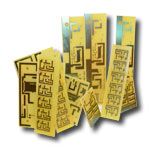Harman Kardon Citation II Amplifier

This 70 pound chocolate colored behemoth, designed by Stewart Hegeman is quite a feat of engineering. It's impressive weight and construction is equally matched by the impressive looking line of tubes, and the conservative 60 WPC power rating. But the really impressive work is "under the hood". Hegeman felt that a good amplifier should not be bandwidth limited to the audible range, but should extend farther in both extremes, so the amplifier can handle the audible range without any of the artifacts of limited bandwidth amplifiers; such as phase shift at the frequency extremes.
This amplifier consists of a pentode input stage, followed by a pair of pentodes as a differential phase splitter. The pentodes Hegeman chose were 12BY7 video pentodes. This choice of tube gives the input stage a bandwidth of well over a megahertz. The output tubes are a pair of KT88's per channel. There is a individual bias controls for each output tube as well as an AC balance control. There is a meter on the back of the amp to measure bias and AC balance. AC balance requires a set of 25 Watt 16 ohm dummy loads be substituted for the speakers. A test signal output RCA jack is supplied on the back of the amplifier. The test signal is fed into each channel and the AC balance pot is adjusted until the meter reads a null.
The output tubes drive a potted transformer which is arguably the best ever built. It was wound by Freed in New York. It has a full power bandwidth of up to about 230 HKz. These transformers look like iron, but sound like gold. They are also scrounged by Bruce Moore for use in his MFA amplifiers. I'm sorry to say that many a Citation II has been gutted for it's iron.
There are three nested feedback loops. The first is from the plates of the phase splitter tubes, to their grids. The second is from the plates of the output tubes to the grids of the phase splitter tubes. The third is from the output transformer secondary to the cathode of the input tube. The total amount of feedback is about 32 dB. This about 10 dB more feedback than a traditional Mullard or Williamson type tube amp. The multiple loops, and fantastic output iron make this possible. The time constants of each loop have been carefully calculated. 10 KHZ square waves (at about 2/3 power) look amazingly good, with just a tiny hint of ringing (one period). This amplifier is amazingly stable for any tube amplifier, let alone a tube amp with that much feedback.
When the passive components in this amp are updated, this amp sounds just amazing. It produces music with an authority and an ease that is unequaled in the audio world. It tends to have a dry and "correct" sound rather than a "tube amp" sound. If you want the warmth and carmel sound of vintage tubes, this may not be the amplifier for you. If you want your music served up honestly with a bare minimum of distortion (and no solid state distortion), this may be the amp for you.
Note:This amp will Eat Quad ESL's, it sounds good, but can fry tweeters instantly

![]() Citation II Capacitor Board (428 Kb)
Citation II Capacitor Board (428 Kb)
Changes I've made to my Citation II
|

